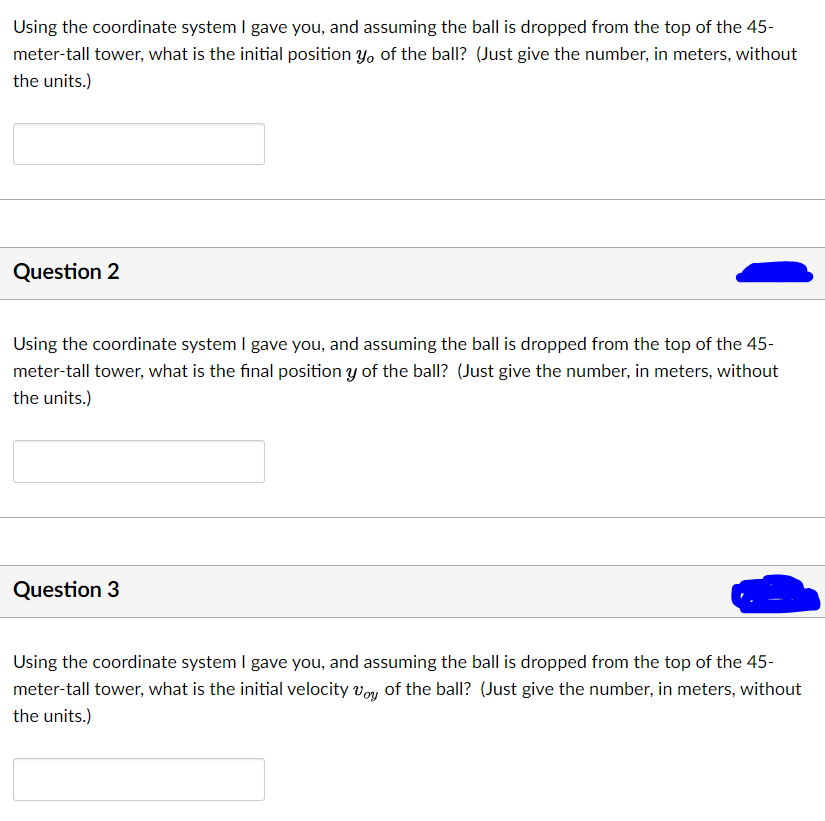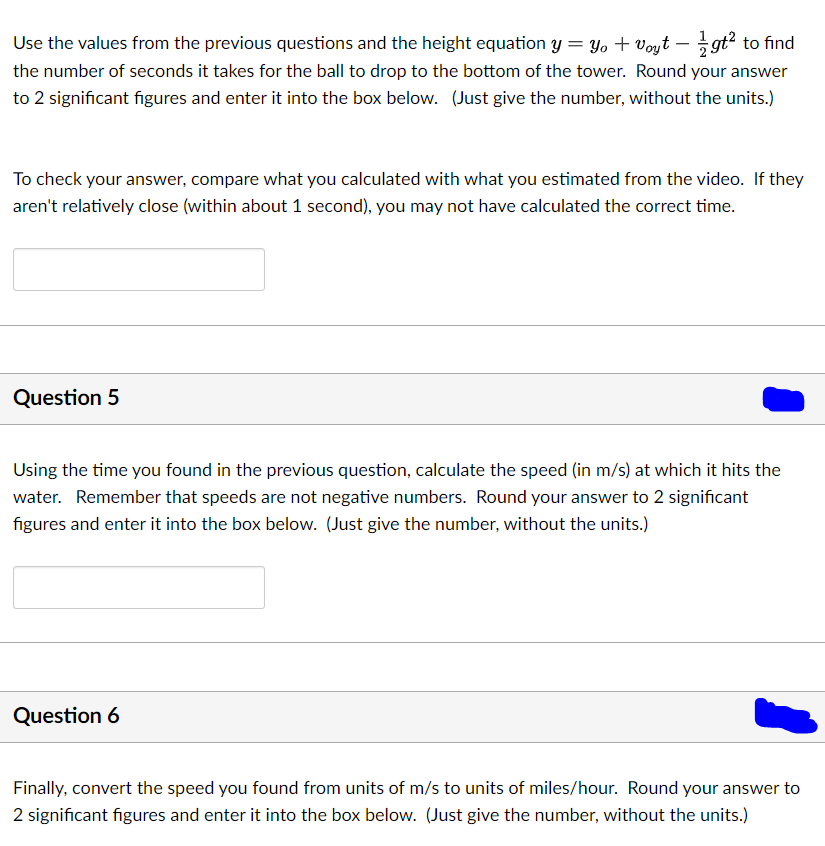Using the coordinate system I gave you, and assuming the ball is dropped from the top of the 45- meter-tall tower, what is the initial position y, of the ball? (Just give the number, in meters, without the units.) Question 2 Using the coordinate system I gave you, and assuming the ball is dropped from the top of the 45- meter-tall tower, what is the final position y of the ball? (Just give the number, in meters, without the units.) Question 3 Using the coordinate system I gave you, and assuming the ball is dropped from the top of the 45- meter-tall tower, what is the initial velocity voy of the ball? (Just give the number, in meters, without the units.)
Using the coordinate system I gave you, and assuming the ball is dropped from the top of the 45- meter-tall tower, what is the initial position y, of the ball? (Just give the number, in meters, without the units.) Question 2 Using the coordinate system I gave you, and assuming the ball is dropped from the top of the 45- meter-tall tower, what is the final position y of the ball? (Just give the number, in meters, without the units.) Question 3 Using the coordinate system I gave you, and assuming the ball is dropped from the top of the 45- meter-tall tower, what is the initial velocity voy of the ball? (Just give the number, in meters, without the units.)
College Physics
11th Edition
ISBN:9781305952300
Author:Raymond A. Serway, Chris Vuille
Publisher:Raymond A. Serway, Chris Vuille
Chapter1: Units, Trigonometry. And Vectors
Section: Chapter Questions
Problem 1CQ: Estimate the order of magnitude of the length, in meters, of each of the following; (a) a mouse, (b)...
Related questions
Question
please please help me with this one problem that relates to every part in here!! they all relate to each other. you need one for another. please help me i am stuck!!! thank you. it takes 4 seconds to reach the bottom of tower.
Use a coordinate system where up is positive and the origin is at the bottom of the tower.

Transcribed Image Text:Using the coordinate system I gave you, and assuming the ball is dropped from the top of the 45-
meter-tall tower, what is the initial position yo of the ball? (Just give the number, in meters, without
the units.)
Question 2
Using the coordinate system I gave you, and assuming the ball is dropped from the top of the 45-
meter-tall tower, what is the final position y of the ball? (Just give the number, in meters, without
the units.)
Question 3
Using the coordinate system I gave you, and assuming the ball is dropped from the top of the 45-
meter-tall tower, what is the initial velocity voy of the ball? (Just give the number, in meters, without
the units.)

Transcribed Image Text:Use the values from the previous questions and the height equation y = yo + voyt - gt² to find
the number of seconds it takes for the ball to drop to the bottom of the tower. Round your answer
to 2 significant figures and enter it into the box below. (Just give the number, without the units.)
To check your answer, compare what you calculated with what you estimated from the video. If they
aren't relatively close (within about 1 second), you may not have calculated the correct time.
Question 5
Using the time you found in the previous question, calculate the speed (in m/s) at which it hits the
water. Remember that speeds are not negative numbers. Round your answer to 2 significant
figures and enter it into the box below. (Just give the number, without the units.)
Question 6
Finally, convert the speed you found from units of m/s to units of miles/hour. Round your answer to
2 significant figures and enter it into the box below. (Just give the number, without the units.)
Expert Solution
This question has been solved!
Explore an expertly crafted, step-by-step solution for a thorough understanding of key concepts.
This is a popular solution!
Trending now
This is a popular solution!
Step by step
Solved in 2 steps with 2 images

Knowledge Booster
Learn more about
Need a deep-dive on the concept behind this application? Look no further. Learn more about this topic, physics and related others by exploring similar questions and additional content below.Recommended textbooks for you

College Physics
Physics
ISBN:
9781305952300
Author:
Raymond A. Serway, Chris Vuille
Publisher:
Cengage Learning

University Physics (14th Edition)
Physics
ISBN:
9780133969290
Author:
Hugh D. Young, Roger A. Freedman
Publisher:
PEARSON

Introduction To Quantum Mechanics
Physics
ISBN:
9781107189638
Author:
Griffiths, David J., Schroeter, Darrell F.
Publisher:
Cambridge University Press

College Physics
Physics
ISBN:
9781305952300
Author:
Raymond A. Serway, Chris Vuille
Publisher:
Cengage Learning

University Physics (14th Edition)
Physics
ISBN:
9780133969290
Author:
Hugh D. Young, Roger A. Freedman
Publisher:
PEARSON

Introduction To Quantum Mechanics
Physics
ISBN:
9781107189638
Author:
Griffiths, David J., Schroeter, Darrell F.
Publisher:
Cambridge University Press

Physics for Scientists and Engineers
Physics
ISBN:
9781337553278
Author:
Raymond A. Serway, John W. Jewett
Publisher:
Cengage Learning

Lecture- Tutorials for Introductory Astronomy
Physics
ISBN:
9780321820464
Author:
Edward E. Prather, Tim P. Slater, Jeff P. Adams, Gina Brissenden
Publisher:
Addison-Wesley

College Physics: A Strategic Approach (4th Editio…
Physics
ISBN:
9780134609034
Author:
Randall D. Knight (Professor Emeritus), Brian Jones, Stuart Field
Publisher:
PEARSON